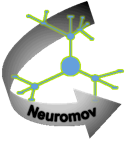detailed view of neuromov



NEUROLOGICAL AND PSYCHIATRIC DISORDERS
DEPRESSION/CHRONIC STRESS
Chronic restraint stress: Restraint stress is applied by placing rodent in wire-mesh restrainer for 6 h daily during 21 consecutive days.
Chronic immobilization and acoustic stress: Animals are immobilized for 1 h per day for 21 days in modified transparent plastic conical tubes with many holes (to allow ventilation) and are placed on the bench top, close to a sonicator bath (acoustic stress).
Chronic social stress (Aggression/Sensory-contact model): Animals are housed in pairs but separated by a plexiglass barrier with many holes that allows the animals to see, hear and perceive each other's odors, but prevents physical contact. This barrier is removed daily for 10 minutes during 10 days, leading to agonistic interactions (aggression).
Chronic unpredictable mild stress: Rodents are subjected several times a day for 6 weeks to one of the following stressors: altered bedding (soiled sawdust, wet sawdust, substitution of sawdust with 21°C water), cage tilting (45°), cage exchange (placing in the empty cage of another male), altered length and time of light/dark cycle, predator sound/odor.
Olfactory bulbectomy: Bilateral destruction of the olfactory bulbs (bulbs are aspired by a suction pump) in rodents results in behavioral, physiological and morphological changes, many of which are comparable to those seen in patients with major depression.
Maternal separation: This model is the most widely used early life stress model. Pups are subjected to separation for 3 h per day from postnatal day 1 (PND1) to PND14.
ANXIETY/ACUTE STRESS
Acute restraint stress: Rodents are placed in a wire-mesh restrainer for 6 hours.
Acute immobilization and acoustic stress: Animals are immobilized for 1 hour in modified transparent plastic conical tubes with many holes and are placed close to a sonicator bath (acoustic stress).
Acute social stress: This model is the same described above (see Chronic social stress) but removing the barrier for 10 minutes only for one day.
Predator sound/odor: Rodents are exposed for 10 minutes to predator sound or odor.
SCHIZOPHRENIA
MK-801 perinatal injection: Rodents are intraperitoneally injected with the NMDA receptor antagonist MK-801 at postnatal day 7 (PND7).
Post-weaning social isolation rearing: After weaning (PND 21), animals are placed in individual cages and remain in isolation until adulthood (PND90-PND120). Rodents reared in isolation can hear and smell other mice, but are unable to see or have physical contact with them.
"Double hit" schizophrenia model: This model combined neurological alterations during perinatal development (MK-801 injection at PND7) and modified environmental conditions (post-weaning social isolation rearing).
PARKINSON'S DISEASE
6-OHDA model: This is the traditional model for testing Parkinson’s therapies, especially those intended to increase dopamine levels in the striatum. The procedure involves the unilateral injection of the toxin 6-hydroxydopamine (6- OHDA) into the substantia nigra. The contralateral hemisphere (non 6-OHDA injected) serves as an intra-animal control. This injection produces dopaminergic (DA) neuron loss on the injected side while sparing the contralateral DA neurons.
MPTP model: This model is thought to mimic more closely the behavioral pathology of Parkinson’s disease, compared to the 6-OHDA model, and is currently the model of choice. Rodents exhibit Parkinson’s-like symptoms following systemic injection of the pyridine toxin MPTP, which produces a loss of striatal dopamine (DA) nerve terminals and, at higher doses, death of DA neurons in the substantia nigra.
Rotenone model: The most recent model of Parkinson’s disease uses systemic injection of rotenone, which disrupts mitochondrial activity and results in a pathology that is very similar to that seen in Parkinson’s disease (e.g., accumulation and aggregation of α-synuclein and ubiquitin, progressive oxidative damage, and caspase-dependent death).
EPILEPSY
Pilocarpine model: Understanding the pathophysiogenesis of temporal lobe epilepsy (TLE) largely rests on the use of models of status epilepticus (SE), as in the case of the pilocarpine model. The main features of TLE can be reproduced in rodents by intraperitoneal injection (i.p.) of pilocarpine; in fact, it induces acute SE more rapidly than kainic acid (i.p.), the other convulsant drug commonly used to reproduce TLE in animals.
ALZHEIMER'S DISEASE
β-Amyloid (Aβ) model: Alzheimer's disease is the most common form of dementia in the elderly. It is characterized by the presence of β-amyloid plaques (which are formed from Aβ fragments), neurofibrillary tangles and synaptic and neuronal cell loss. The rodent Aβ model of Alzheimer's disease is induced by injecting Aβ fragments into the hippocampus, which induces degeneration of neurons of the hippocampal CA1 subfield, and produce behavioral, neurochemical and histological changes resembling those occurring in Alzheimer's disease.
Transgenic models: Tg2576 mice over-express a mutant form of the amyloid precursor protein, developing amyloid plaques. Other transgenic models can be available under client request, please contact us.

